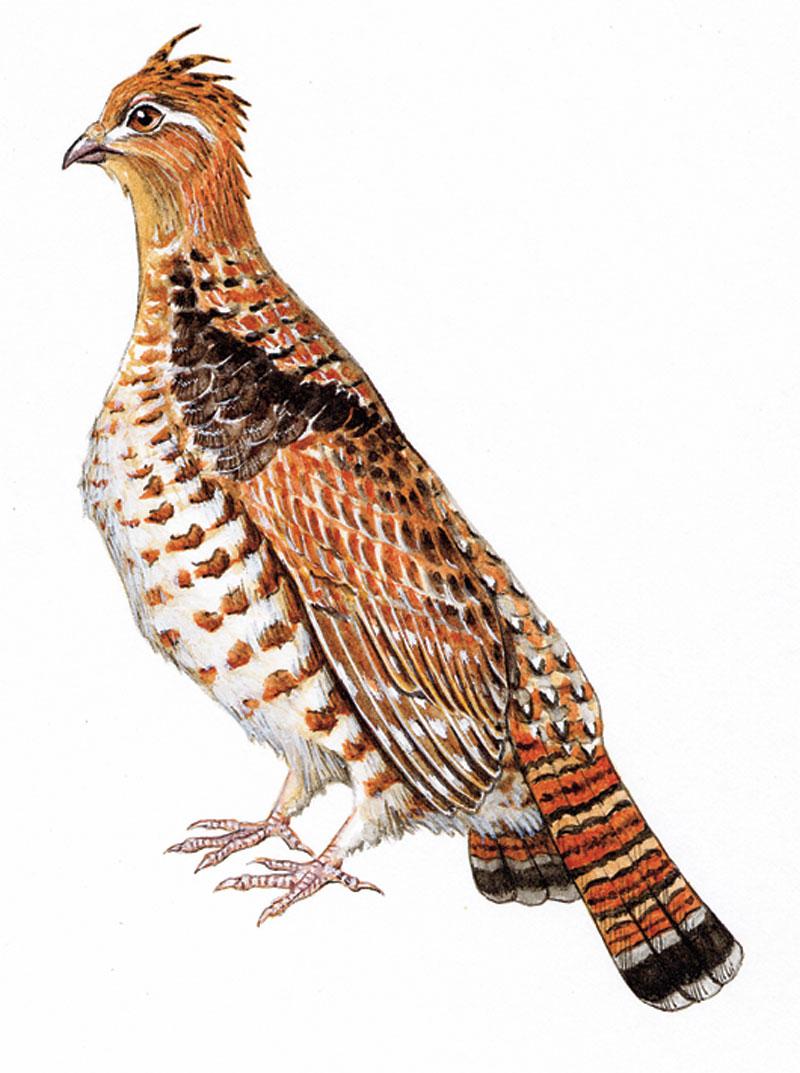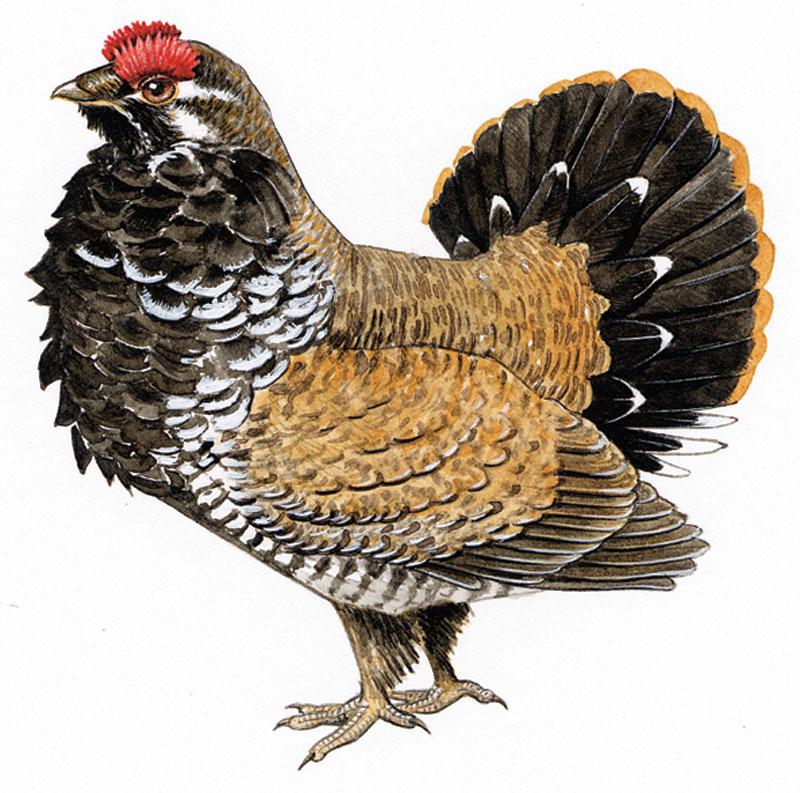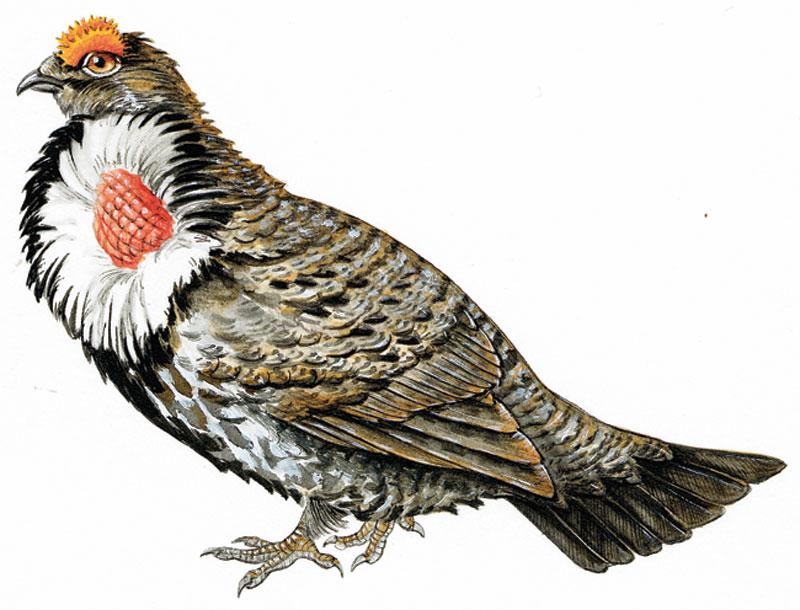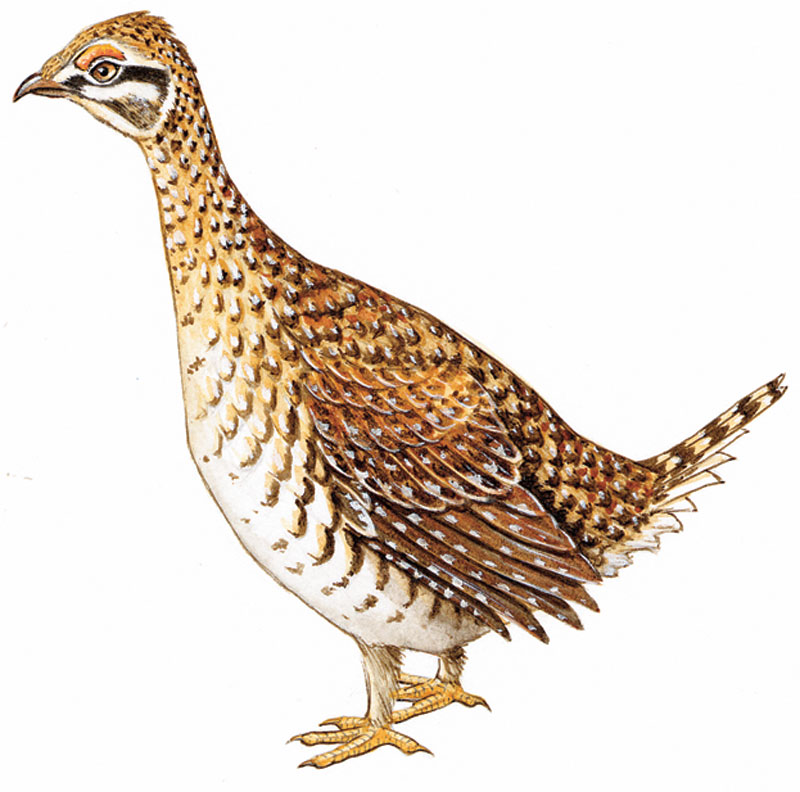Everything You Need to Know to Have a Successful Hunt
Advertisement
Ruffed grouse
Species: Bonasa umbellus
Average Length: 43 cm
Advertisement
Average Wingspan: 56-64 cm
Average Weight: 635 g
Variations: red and grey morphs, which are more widespread
Advertisement
Female: dark band on tail fan incomplete in centre
Song: short quit-quit when threatened
The acknowledged royalty of native grouse—prized for both its sporting and table qualities—the ruffed grouse is so-named because of its ruff, or frill of dark feathers around the neck. Referred to locally as “ruffies” or “partridge,” these birds range from Nova Scotia to the Yukon, absent only in the extreme north of Quebec, Labrador, Nunavut and part of the Northwest Territories. The familiar drumming of the male ruffed grouse during mating season is one of the welcome harbingers of spring across its range.
Even in times when their population cycles are peaking, ruffed grouse are only found where there is suitable habitat that offers both food and escape cover (ruffed grouse undergo severe population fluctuations in cycles that range from seven to 11 years, the exact cause of which remains unclear). Look for second-growth deciduous and mixed wood forests-complete with a dense layer, or understory, of shrubs beneath the main canopy—interspersed with natural openings and/or man-made edges.

Favoured food shrubs include aspen, saskatoon, hawthorn, hazelnut, chokecherry, willow and alder. In the late fall and early winter, it is the availability of these rich food sources that most affect ruffed grouse distribution. Before the snow arrives, you should also look for ruffies wherever there is clover adjacent to escape cover. Clover is akin to candy to these birds, whether it’s clover seeded for hay or the wild native variety.
The best times to hunt ruffed grouse are at first and last light. They are most active during these shoulder hours of the day in part because these are the transitional periods for avian predators. Nocturnal hunters, such as the great-horned owl, have either just finished their shift or not quite started it; the same can be said of daylight hunters, such as the goshawk and red-tailed hawk. Simply put, it’s a safe time for ruffies to be out and about.
If hunting without a dog, work creek bottoms, cutlines, tree-lined trails and forest edges. All of these locations provide the chance to spot a grouse at a distance as it feeds, suns or dusts itself. You can then plan a stalk to put yourself in the best possible shooting position.
I’ve had considerable luck walking the edges of grass and clover hayfields that abut against dense forested cover. Work these areas slowly and carefully, as ruffed grouse are notorious for sitting tight a metre or two into the cover and, displaying the guts of a gunfighter, holding still as you walk past. A stop-and-go technique will often put up birds that would otherwise hold fast; when you stop, they fear they’ve been spotted and flush.
If you put up a bird, continue to thoroughly work the area. Where there is one there will often be others nearby, as ruffed grouse remain in family units through much of the hunting season.
As much as they use their eyes, experienced ruffed grouse hunters also use their ears. It is not uncommon to pinpoint grouse by hearing them shuffle away on the dead leaves carpeting the forest floor. When you do, immediately walk in on them and you’ll often be rewarded with a shooting opportunity.
If you flush a bird, but fail to down it, don’t hesitate to follow it. Just ensure that you are now hunting with your eyes skyward instead of on the ground, as grouse that have been bumped will invariably settle in a tree. Seldom will they fly more than 100 metres before alighting and, more often than not, they’ll travel less than 50.
If you do down a grouse, mark it immediately. Without a dog to help, it can be all but impossible to locate. I recommend retrieving a downed grouse before trying to shoot another, even one that appears to be an easy shot. Experience has taught me that you’ll put more in the freezer this way over the long run.
Those hunting with dogs have the added flexibility of being able to hunt thicker cover. This is particularly beneficial in poor weather and later in the season, when ruffed grouse tend to occupy more protective cover. A well-trained dog allows you to hang on the periphery of dense thickets while it works the thick stuff and roots out birds that may be hunkered down. Try to set up in anticipation of where a bird will go to seek escape cover if flushed. Keep in mind that, all things being equal, a ruffed grouse will usually swing downwind after it has been flushed.
Solo ruffed grouse hunters can certainly enjoy success, but hunting in tandem provides several advantages. Most importantly, two hunters are by definition twice as likely to find themselves on a potential escape route for a flushed bird. A single hunter invariably finds himself on the wrong side of the cover when birds flush. And a second pair of eyes and ears also helps in spotting and following birds in cover, while dramatically improving the odds of finding a downed grouse.
Spruce Grouse
Species: Falcipennis canadensis
Average Length: 41 cm
Average Wingspan: 58 cm
Average Weight: 499 g
Variations: subspecies Franklin’s grouse lacks chestnut band on tail tip
Female: lacks male’s red eye comb; red and grey morphs
Song: clucks when threatened; males make low hoot

Although its apparent lack of fear of humans often makes it an easy mark, the spruce grouse is generally not targeted by hunters across much of its range. This is especially so during late season when the bird’s diet shifts to pine needles, giving its flesh a strong, gamey taste. It, too, is found from coast to coast, except in the southern Prairies and the northern tundra. In parts of B.C. and Alberta, there’s a sub-species of the spruce grouse known as the Franklin’s grouse.
Although a dense understory of food-bearing shrubs is as important for spruce hens as it is for ruffies, sharp-eyed hunters will spend their time scanning the trees rather than the forest floor. That’s because spruce grouse prefer to roost above the ground, most often in coniferous- or mixed wood-dominated stands.
And due to their preference for inhabiting thickly forested areas with limited visibility, they are less susceptible to avian predators, meaning there’s no particular time of day that’s best to hunt them. Having said that, spruce grouse feed more actively at first and last light, and the inherent movement and noise can help reveal their exact whereabouts.
Generally speaking, spruce grouse carry out their daily routines in relatively confined quarters, often no more than a handful of hectares. Flushed birds seldom fly more than 30 to 40 metres, but they can be nearly impossible to spot again because of their preference for sitting tight to the trunks of spruce trees.
Hunting these birds is very often a spot-and-stalk proposition, and given that they’re so much more arboreal, or tree-oriented, than their cousins the ruffed grouse, the value of a dog is somewhat limited-except, of course, when locating downed birds.
Spruce grouse are a much more worthy game species than their moniker “fool hen” would suggest. Unfortunately for them, however, their escape mechanism when dealing with natural predators is to remain motionless, relying heavily on their naturally camouflaged plumage. They did not evolve with man as one of their primary predators, so hunters often mistake this behaviour as a sign of stupidity.
Spruce grouse also have an unwarranted reputation as poor fare for the pot. While it’s true that the dark meat of the spruce grouse will never rival the succulent taste of the ruffie’s firm, white flesh, neither will your average grocery store chicken. But far too many hunters turn up their indignant noses at what is a fine table bird, particularly in the early season.
The bad rap typically comes from late-season big-game hunters, who often take spruce hens opportunistically. The problem is, with the onset of winter spruce grouse rely more on coniferous needles as the main staple of their diet, and this does impart a less desirable flavour to their meat. Hunt them in the early fall, though, and a spruce hen is sure to satisfy even the most discriminating palate.
Blue Grouse
Species: Dendragapus obscurus
Average Length: 46-53 cm
Average Wingspan: 61-71 cm
Average Weight: 1.2 kg
Variations: coastal variation has yellow neck sac and gray tail band
Female: lacks male’s yellow-orange eye comb
Song: hoots and moans during mating season

The blue grouse is the largest of Canada’s hunted native upland birds, and because of its dark plumage it goes by several different names, including dusky and sooty grouse. Its Canadian distribution is mainly restricted to mountainous regions of B.C. (including Vancouver Island and the Queen Charlotte Islands), the southern Yukon, southwest Nunavut and western Alberta. Dedicated blue grouse hunters are few, due largely to the difficulty in accessing the bird’s preferred mountainous habitat, as well as its limited distribution.
There’s no great mystery to finding success when hunting blue grouse. You just have to be tougher than they are. Of course, that’s much easier said than done, as the blue’s home is one of steep slopes, dense cover and a labyrinth of shin-shattering deadfall. As one veteran blue grouse hunter told me, “Think high-altitude moose and grizzly habitat, and you’ve got a pretty good idea of where to start looking for blue grouse.”
Not surprisingly, there are relatively few hardcore blue grouse hunters out there, but among the aficionados of this husky bird, many take advantage of logging roads to get into prime hunting country. While this approach does little to spare your shins and knees from their inevitable fate, it does offer some relief to your lungs to drive part way up the slope. This is especially so as autumn progresses and blues migrate to increasingly higher elevations.
Blue grouse have an affinity for logging regeneration sites or burned over areas, zeroing in on the succulent and plentiful food offered by young, second-growth forests. Blackberry, salal and huckleberry shrubs are among the key signs of potential blue grouse habitat. Look for small coveys of two to six birds, or individuals sunning themselves on bare, open ground or roosting high in coniferous trees.
Blues are unpredictable in that some will sit tight, refusing to flush even when clearly threatened, while others will rocket away as if on fire. In the latter case, they offer as challenging a target as any sportsman or woman could hope to discover. This is especially so because of the birds’ habit of fleeing downhill, leading many hunters to shoot over them.
Flushed coveys will often separate, although the individual birds can typically be found again. They’ll be justifiably nervous, however, and as a result they can flush early and hard, offering a challenge to even the best shotgunners. In the case of reluctant birds, dogs are a decided advantage when it comes to flushing and they offer yeoman service in locating and retrieving downed birds in impossibly thick cover.
Finally, among the best of their many characteristics, blues offer delicious table fare, and their large size makes them an enviable addition to the winter’s meat supply.
Sharp-tailed Grouse
Species: Tympanuchus phasianellus
Average Length: 41-48 cm
Average Wingspan: 53-64 cm
Average Weight: 953 g
Variations: darker plumage north of the Prairies
Female: similar plumage to male
Song: chattering and soft coo; louder in mating season

Often erroneously referred to as the prairie chicken, which is a distinct and separate species, the sharp-tailed grouse is widely distributed across Canada, from northwestern Quebec to central B.C., and north through the Yukon and western Nunavut to the Mackenzie River delta. As a result, it has succesfully adapted to a variety of habitats, from prairie grasslands to wooded parkland. A favourite of hunters for their sporting qualities, sharpies still rank below the vaunted ruffed grouse when it comes to table fare.
If there’s one piece of advice that prospective sharptail hunters should heed, it is this: Be prepared to walk. And then walk some more. And some more after that. The reason? Sharp-tailed grouse live in large coveys, and finding a covey in large tracts of suitable cover can be like looking for the proverbial needle in a haystack. When you do find them, however, the action can be fast, furious and exhilarating.
In agricultural areas, hunt patches of pasture, windrows, native shrub cover or slough bottoms adjacent to cereal crops. Sharptails have learned to take advantage of the plentiful availability of spilled or waste grain, and they’re seldom far away when it is abundant in their home range.
Beyond cropland, the search for sharptails can be considerably more difficult. The best bet is to concentrate on areas with abundant food sources, such as grass or forb seeds and fruit-bearing shrubs. A particular favourite is chokecherries, which satisfy both the bird’s food and cover requirements.
Sharp-tailed grouse hunting is definitely best suited to the hunter who is accompanied by a dependable dog, particularly a pointing dog, which can save your soles some wear and tear by covering lots of ground, yet hold found birds until you drag your weary carcass into position. And given that sharptails are a covey bird, with normal group numbers ranging from eight to upwards of 40 birds, they are best hunted by two to four hunters working together.
Flushed sharptails seldom, if ever, rise as a unit, so a little pre-planning can markedly increase your success. Usually, these birds flush as singles, though often in rapid succession. You can bet the farm that there will always be some who hold after the first flush, however, so be prepared for late departures. Too often I’ve seen two hunters shoot at the same sharptail, leaving a pair of unloaded guns when a late-flushing bird rises well within range.
Once they know they are being pursued, sharp-tailed grouse are notorious for flushing at great distances from your position. And it only takes one spooked bird to flush all the birds in the covey. Since they typically occupy open habitat, at least you can usually see where they settle after being flushed-although it may be several hundred metres from where they first rose.
In this scenario, it can be a productive tactic to have one or two hunters circle wide around the settled birds’ location while another gunner approaches in a straight line. That way, when the birds flush again, even if they get up early, there is a good chance they’ll pass within range of one of the hunters.
Also remember that when a covey of sharp-tailed grouse initially flushes, it more often than not splits into smaller groups. Make a mental note of where each group lands, then pursue them one at a time. A divide-and-conquer mentality can often pay big dividends.
Unlike the unpredictable flushing patterns of ruffed and spruce grouse, sharptails generally get up and fly straight away-with a consistent flap, flap, flap, glide-from whatever has threatened them. As a result, inexperienced sharptail hunters have a habit of putting the bead right on the bird, leading to a clean miss below the disappearing target. Remember to hold slightly over them when they flush and your success rate will go up significantly.
